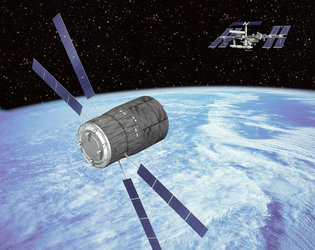CNES to run ATV Control Centre under ESA contract
In the elegant modern style Fermat Building of the Toulouse Space Centre, the French space agency CNES, under a contract signed with ESA on 17 April 2003, will develop and operate, by September 2004, a space control centre specialised in handling Automated Transfer Vehicle (ATV) missions in orbit.
Under the contract, signed by Jörg Feustel-Büechl, ESA’s Director of Human Spaceflight, and Yannick d'Escatha, President of the French space agency, CNES will also take responsibility for the development of the ATV Control Centre (ATV-CC), and prepare, coordinate and support all ATV operations on behalf of ESA.

“It’s an honour for me to welcome you here, in Toulouse, for the signature of the contract regarding the development and operations of the ATV Control Centre”, said Yannick d'Escatha. “The main mission of the ATV will be to re-supply the International Space Station with consumables and scientific equipment”.
The ATV is an unmanned vehicle that will be put into orbit from Kourou, French Guiana, by Europe’s Ariane 5 launcher. It will supply the International Space Station (ISS) with pressurised cargo, water, air, and refuelling propellant for the Station’s propulsion system. It will also remove waste from the Station and periodically re-boost the Station to a higher altitude to compensate for atmospheric drag. The first ATV, named Jules Verne, is expected to be launched in 2007 and to dock with ISS where it will stay for up to six months.

“The ATV-CC will be responsible for the analysis of the mission, and the preparation and validation of the monitoring and control tools used by the 30-person control room staff during the mission. The Control Centre is also responsible for carrying out the pre-programmed mission plans and, if needed, to implement any changes. Additionally the Centre is in charge of the orbitography, the localisation of the ATV and the optimisation of its approach to ISS. This is a very difficult task and requires a very high degree of technical skill because it will be the first time that Europe accomplishes this objective,” said Jörg Feustel-Büechl.
Among the different flight control capabilities, the ATV-CC will also be able to direct the undocking of the ATV from ISS. The Control Centre can then command an operation to keep the ATV in the vicinity of ISS for up to eight weeks, if needed, before a re-docking.
After launch, the ATV will separate from Ariane 5, and under the responsibility of the Control Centre in Toulouse, using its own navigation systems, will make a three-day journey to ISS where its eye-like rendezvous sensors will be used to dock automatically. The ATV will remain an integral Station element for up to six months. Finally, the ATV, loaded with 6.5 tonnes of waste, will be remotely separated from ISS by the same Toulouse centre, and will fully burn up during a guided and controlled re-entry high over the Pacific Ocean.

The mission scenario will require complex interactions and shared responsibilities between space organisations dispersed throughout the world. First, the ATV-CC will work with the Guiana Space Centre, in charge of launch and deployment of the ATV. For rendezvous, docking and departure, the ATV-CC will work in close coordination with the Mission Control Centres in Moscow and Houston. All the ATV ground control commands will be issued by Toulouse. In case of a major malfunction during the rendezvous, the ATV-CC, as well as the ISS crew, can initiate the collision avoidance manoeuvre to move the 20-tonne spaceship away from the Station.
To allow continuous coordination with the other control centres and to remain in constant contact with the ATV during the mission, using relay satellites - like TDRS and Artemis -, the ATV-CC will rely on the European communication network, called the Interconnection Ground Subnetwork (IGS), which is based at the GSOC (German Space Operations Centre) of DLR, at Oberpfaffenhofen in Germany.
At the end of 1998, the ESA Council decided to locate the ATV Control Centre at the CNES space centre in Toulouse and to have CNES as Prime Contractor for ATV operations. Since the mid-1970s, CNES teams in Toulouse have acquired a wealth of experience in Europe by positioning and manoeuvring numerous low orbit and geostationary satellites.
A follow-up contract for the ATV exploitation phase, announced by Mr Feustel-Büechl, will soon allow the ATV-CC to be operational for at least 10 years. Over this period it is expected that ESA will build and launch at least 7 Automated Transfer Vehicles towards ISS.





